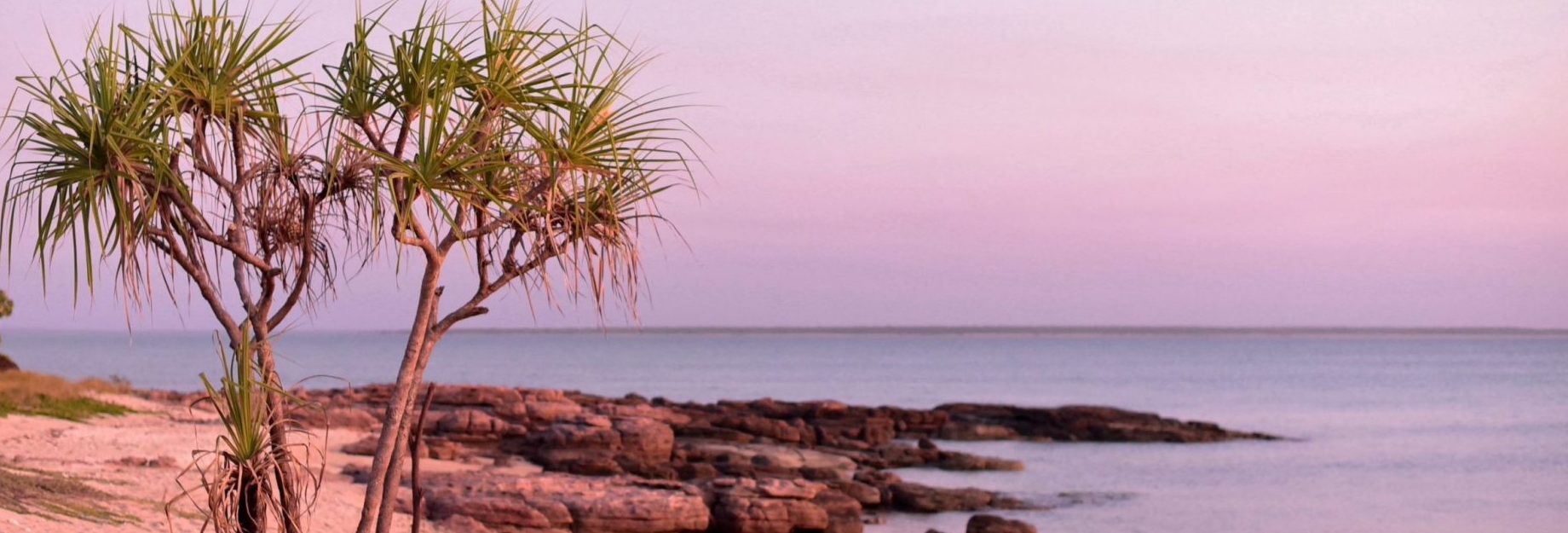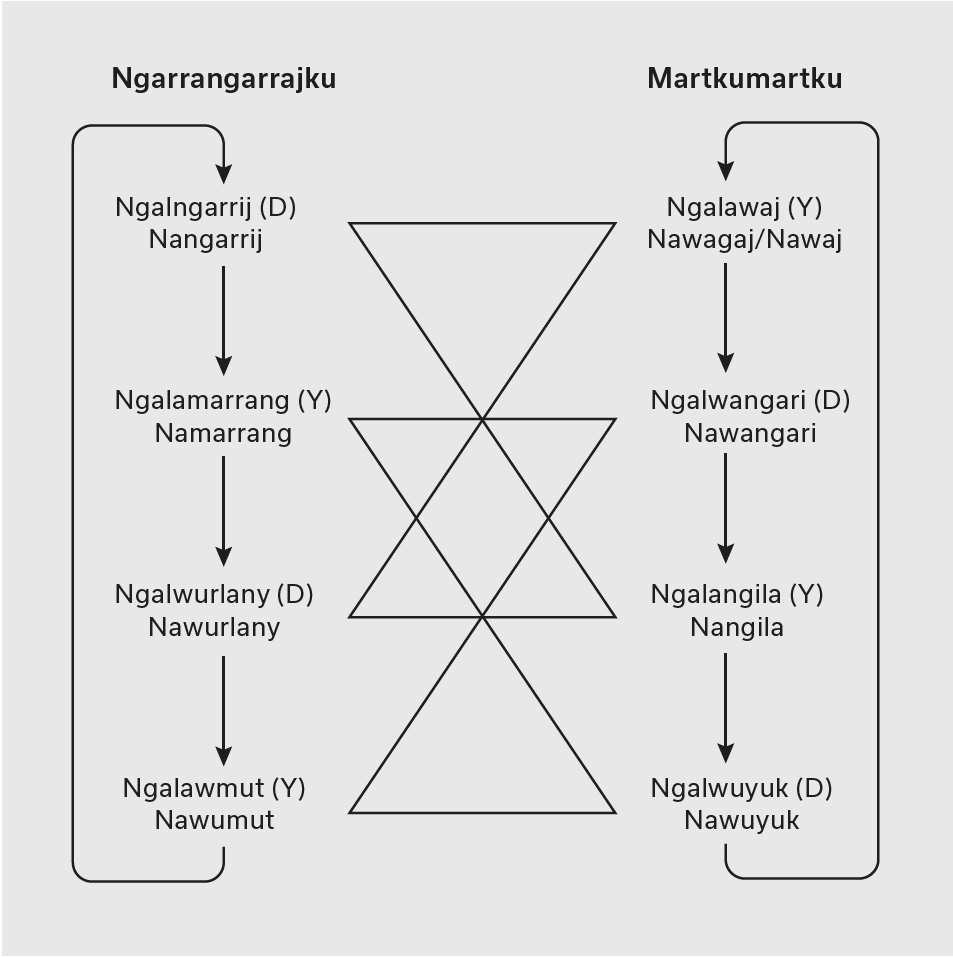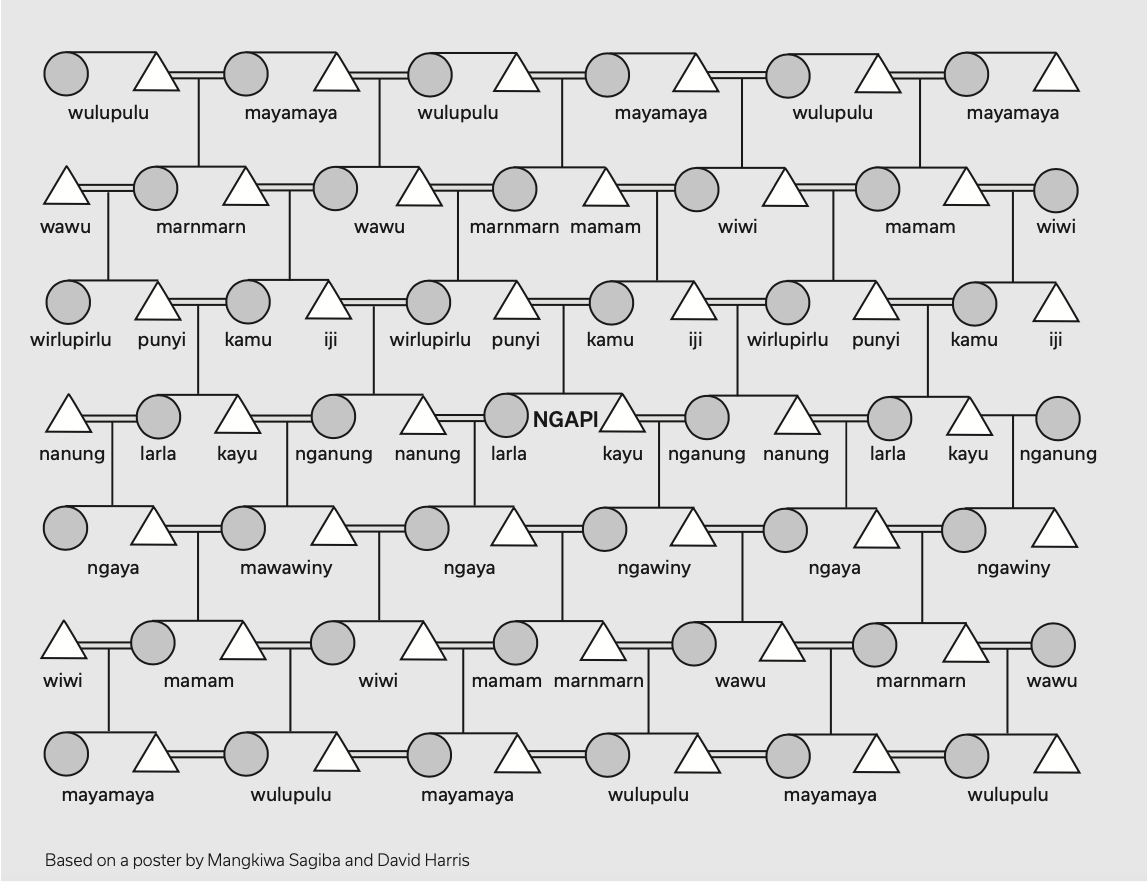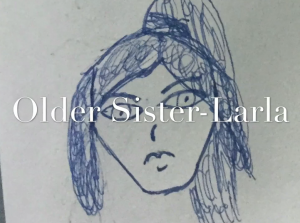Mawng words for family

Words for Family
Mawng is very rich in words for people in the family (kin terms). In the past, personal names were not used very often by Mawng speakers. It is still considered more polite to use kin terms in many situations.
There are over 200 kin terms in the dictionary which can be divided into five main types:
1. skin names (subsection terms) such as Nangila
2. simple kin terms such as larla ‘older sister’
3. totem names (phratries or matries) such as yarriyarnkurrk
4. kinship verbs such as kini-malkpa ‘he is father to him’
5. kunteypi, very polite and often complex terms
The first two kinds of kin terms in the list above are found in most Australian Indigenous languages.
The last three kinds are unusual but not unique to Mawng.
Totem names, as phratries are called at Warruwi, are also found in other nearby languages such as Iwaidja and the Kunwinjku variety of Bininj Kunwok.
Kinship verbs are found in other Iwaidjan languages (see Iwaidjan, a very un-Australian language family, Evans, 2000) and kunteypi kin terms in Mawng are very similar to kunderbi in neighbouring Bininj Kunwok (Garde 2003).
Kunteypi are especially polite ways to refer to people in the family. Most are tri-relational, so they specify family relationships between three people rather than the usual two. Kunteypi terms can be difficult to define using English, so some kunteypi dictionary entries use simple Mawng kin terms to define them. Mawng speakers usually only master kunteypi as adults, and for Mawng learners it is important to understand the other kin terms first.
Skin names
Skin names (subsection terms) are often used instead of personal names. The names of each matrimoiety are shown at the top of the chart below. Each is divided into four subsections, with a pair of male and female names for each subsection, so if I am Ngalngarrij then my brother is Nangarrij. The arrows represent the relation between a mother and her child. For example, if your mother is Ngalngarrij, then you will be Ngalamarrang or Namarrang.

The lines in the centre of the image above represent ideal pairings for arranged marriages (which are no longer widely practised). For example, Ngalngarrij should marry Nawagaj or Nangila.
Kin terms can be used for anybody who has a skin name. So you can use larla ‘older sister’ for anyone who has the same skin name as you, and you can use kamu ‘mother’ for anyone who has the same skin name as your mother.
The eastern Arnhem Land patrimoieties, called Duwa and Irritja in Mawng, can be mapped onto the Mawng moieties as shown by the letters ‘(D)’ and ‘(Y)’ in the diagram. In addition to the skin names shown in the image above, there are plural forms such as ngalngarrangarrij ‘two or more people of Ngalngarrij skin’ and ‘friend’ terms such as ngalyikngarrij ‘friend who is Ngalngarrij skin’.
Simple kin terms
Mawng simple kin terms are shown in the image below which follows a standard format for kinship charts. The triangles represent males and the circles represent females. Double lines represent marriages and ngapi ‘I’ is ego (i.e. the person naming their family members).

Totems
Mawng has a system which is known locally as ‘totems’ and has been called phratries or matries by researchers (Harvey & Garde 2016). Each person has exactly the same totem as their mother, so these names do not cycle through the generations like skin names do. But because they are matrilineal the totems can be grouped under matrimoieties, just like skin names. Each totem is associated with certain items as listed in the table below.
The list is incomplete and there is some disagreement about where some items should go (note that walanurru ‘Brahminy Kite’ appears in two columns).
There is a fifth totem witjin in the table which is part of the yarriyarnkurrk totem.
The names for each totem in this table are the names used for men of that totem. There is a separate female term for each totem, e.g. ninyarriyarnkurrk. The plural term may also be used as a name for the totem. e.g. manjarriyarnkurrk.
The first item listed for each totem, e.g. waryat ‘stone’ is what people usually say to name the totems.
| Ngarrangarrajku | Martkumartku | ||
| yarriyarnkurrk | yarriwurrkarr | yarriyarniny | yarriwurrik |
| waryat ‘stone’ | murwala ‘pandanus’ | muwarn ‘sun’ | yungku ‘fire’ |
| manpiri ‘turtle’ | kawagawa ‘white egret’ | wirlmu ‘barramundi’ | nganaparru ‘buffalo’ |
| wampirlpaya ‘echidna’ | mularrik ‘frog’ | alapika ‘flatback turtle’ | yanpiyanpi ‘king brown snake’ |
| walmat ‘rain’ | ngalagayu ‘little corella’ | ngunymin ‘rock cod’ | walanurru ‘brahminy kite’ |
| mangalpitan ‘jabiru’ | karrak ‘red-tailed black cockatoo’ | arnpurrik ‘wedge-tailed eagle’ | martingunyuny ‘dugong’ |
| walanurru ‘brahminy kite’ | alkparn ‘Giant shovelnose ray’ | kurnpirripirri ‘saltwater crocodile’ | kantakij ‘kangaroo type’ |
| manimunak ‘magpie goose’ | kuntaruk ‘possum’ | wukurl ‘eastern reef egret’ | marrwati ‘sea eagle’ |
| wurakak ‘crow’ | wanyjarlarr ‘queenfish, skinnyfish’ | makakurr ‘pelican’ | wampa ‘shark’ |
| wilitpilit ‘magpie lark’ | kalmaya ‘green ant’ | kujpagarri ‘agile wallaby’ | majirnti ‘large hawksbill turtle’ |
| wutput ‘pheasant coucal’ | murtij ‘estuary stingray’ | pulikang ‘cattle’ | |
| mirrijpu ‘seagull’ | kurrana ‘moon’ | jarrang ‘horse’ | |
| nawariyu ‘whistle duck’ | nanikut ‘goat’ | ||
| kamiru ‘radjah shelduck’ | luluj ‘(introduced) dog’ | ||
| karlarrk ‘red-winged parrot’ | warlk ‘tree, wood’ | ||
| mangili ‘freshwater tortoise’ | |||
| manuk ‘freshwater snake’ | |||
| wulminkaykay ‘file snake’ | |||
| karnjawarra ‘mud crab’ | |||
| mawuga ‘mangrove crab sp.’ | |||
| murrumpun ‘black wallaroo’ | |||
| witjirrk ‘yellowtail grunter’ | |||
| wurrut ‘trevally (generic)’ | |||
| ikaman ‘freshwater catfish’ | |||
| Witjin | |||
| munma ‘ olive ridley turtle’ | |||
| najarrari ‘ little red flying-fox ‘ | |||
| nawayati ‘loggerhead turtle ‘ | |||
© Dictionary compliation, Ruth Singer and Warruwi Community 2021. Mawng speakers own the Mawng language. They also own their knowledge of plants, animals, kinship, Mawng country, customs and history which is compiled in this dictionary.
© Dictionary compliation, Ruth Singer and Warruwi Community 2021. Mawng speakers own the Mawng language. They also own their knowledge of plants, animals, kinship, Mawng country, customs and history which is compiled in this dictionary.

